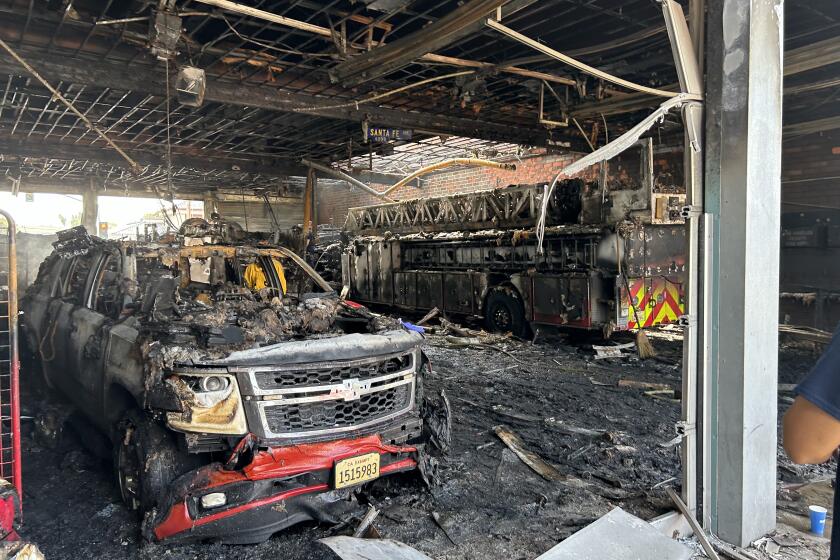Learning to flex their civic muscles
Maria Ortiz’s civic awakening began when her husband fired a pistol into their front yard to ward off a gang member who had insulted him.
Jose Ortiz hailed from a mountain village in Durango, Mexico, where residents were sometimes forced to take matters into their own hands because law enforcement was so far away.
But Ortiz was no longer in rural Mexico, and he spent time in jail for his actions.
The gang member and his cohorts laughed at the Ortizes. Residents in their Florence-Firestone neighborhood didn’t help.
The family considered selling their house and moving from the neighborhood where they had lived for two decades.
But Maria Ortiz said no. Short and garrulous, she had come to the United States from Mexico at age 6 and knew little about how government worked. She knew, however, that her poor and crime-ridden neighborhood was in trouble, and she wanted to do something about it.
So, in late 2004, Ortiz volunteered when Herman Barahona, of Los Angeles County’s Community Development Commission, showed up a few months later asking for help in organizing residents to battle crime and blight. It was part of a larger county campaign launched to reach long-neglected communities.
It was a big job. And a difficult one. To succeed, Barahona, who is bilingual, would have to enlist the help of the neighborhood’s mostly Mexican immigrants, who, like the Ortizes, were either unfamiliar or distrustful of government.
Barahona started by holding meetings at local churches and schools with a few immigrant parents, teaching a kind of Civics 101 class. Among the parents were several mothers at Lillian Street Elementary School, including Ortiz, who worked as a campus aide and whose son attended the school.
Barahona taught them about each county department, such as Code Enforcement and Public Works, and how and where to go for help. Mostly he wanted to give them a sense of empowerment.
“I came out feeling everybody has the same worries” about gangs and blight, said Ortiz, who is bilingual and made the leader of the mothers’ group. “I knew I wasn’t alone.”
What happened stirred a change in Ortiz and the others. They set out to clean up their neighborhood, focusing primarily on the area around the elementary school, which also struggled with a poor academic record.
Today, much of the blight around the school is gone and test scores are up. Crime is also down in the neighborhood, which is seeing new housing and commercial development for the first time in years.
But officials caution that there is still a long way to go.
Extending north of Watts, unincorporated Florence-Firestone is a jumble of modest stucco houses, factories and mom-and-pop stores. A working-class community of 60,000, it has seen many demographic shifts over the years.
Above all, Florence-Firestone is “a place for people from someplace else,” said resident Joe Titus, 79, one of the area’s remaining white residents.
In his lifetime, Titus has seen wealthy whites, followed by middle-class blacks, move in, then out. Over the last 20 years, the neighborhood has become predominantly Latino.
Their work and spending has helped spark the local economy. The area’s first shopping center in four decades is going up at Alameda Street and Florence Avenue, and new town houses have gone up on Gage Avenue. Meanwhile, three-bedroom houses in the neighborhood are selling for $500,000. But Titus complains that residents could do more to erase neighborhood blight. Many in the immigrant community have had little contact with government and so often don’t report graffiti, street trash and building code violations, he said.
“They don’t know that if you call, these problems could go away,” said Titus, who serves on the Chamber of Commerce and organizes a Block Watch.
The neighborhood around Lillian was an example of how bad things could get.
No one said much when an illegal nightclub opened near the school. It operated on weekends, and often the area was left littered with condoms, syringes and broken bottles.
Bordering the campus, the Union Pacific railroad tracks had become an illegal dump -- piled with old sofas and stripped cars -- and a homeless encampment.
Then in early 2005, a flier circulated announcing that a trucking company near the school wanted to start a vehicle paint shop -- another source of pollution.
But by this time the county’s civic experiment led by Barahona was taking root. It was part of a push to make county agencies provide services with the same speed and accountability as cities do. Florence-Firestone was the county’s test case.
When the paint-shop flier arrived at Lillian, Ortiz and the other mothers had been meeting with Barahona for several months. He counseled them on how they might oppose the new business.
“We learned how to put together an agenda, what questions to ask” public officials, said Maria Hernandez, one of the mothers.
The women met with officials from the state, county Public Works and Regional Planning departments, and a representative of county Supervisor Gloria Molina. They collected more than 700 signatures in a neighborhood petition drive.
They later researched the trucking company and learned that it already had opened the paint shop, even though it was zoned only to sell trucks. They sought out the help of a county planner, and the shop was quickly closed.
“People began to believe in us a little more,” said Victoria Carrasco, another one of the neighborhood mothers who participated in the campaign.
The women then focused on the illegal nightclub. After a few phone calls, its doors also closed for good. They also urged officials to speak to Union Pacific, which agreed to allow county workers to go on its property and clean debris along the tracks.
In May 2005, county officials held a community meeting at a nearby middle school to announce that Lillian’s lessons were being expanded to all of Florence-Firestone.
The school gymnasium was packed. Supervisors Molina and Yvonne B. Burke, whose districts include a portion of the neighborhood, were among those on stage -- a first, and taken as a sign of a new collaboration between them.
Ortiz, though terrified, gave her first public speech, about neighborhood improvements that included new traffic lights and street crossings.
With those first successes behind them, she told the crowd, it was time to move on to other challenges. Residents needed to lobby for more patrols by Los Angeles County sheriff’s deputies to address the neighborhood’s growing crime problem, she said.
At the time, Florence-Firestone was in the middle of a surge in violent crime, with 41 homicides recorded in 2005 -- surpassing the homicide rate in some of the nation’s most dangerous big cities, authorities said. About half of those killed had no gang affiliation.
At a community meeting, Sheriff’s Lt. John Babbitt surprised Ortiz and others by asking for their help in combating crime.
Babbitt had been tapped as the first lieutenant assigned to Florence-Firestone as part of the county’s civic experiment.
It was a tough assignment for a former SWAT supervisor with no experience in community policing and who didn’t speak Spanish.
To complicate matters, many in the immigrant community were distrustful of law enforcement.
“We thought only negative things about the police,” Ortiz said.
But residents were impressed when under Babbitt, the Sheriff’s Department assigned 60 more deputies to Florence-Firestone. A special prosecutor was also sent to try neighborhood homicide cases.
Babbitt renovated a sheriff’s substation and moved his offices there. When Ortiz asked him to speak to Lillian schoolboys who were forming a small gang, Babbitt and three deputies showed up in uniform.
To help build trust in the community, Babbitt gave his cellphone number to neighborhood leaders. He also called in code enforcement officers on gang and drug houses -- two of which have been destroyed. With the help of Public Works, he cleaned up a block of 93rd Street that had become another illegal dump.
And at his urging, some 200 residents have gone through the Sheriff’s Department’s Community Academy, where they are taught about homicide investigations, the jail system, domestic-violence laws and emergency preparedness.
“We learned how they do their job, which is something we didn’t know,” Ortiz said. “What’s been achieved is unifying the community with the police.”
Since the Florence-Firestone experiment began, the neighborhood has had many successes.
Crime is down. Last year, homicides dropped in half to 19 after a major law enforcement crackdown.
In October, federal prosecutors announced a massive indictment, charging 102 members of the Florencia 13 street gang with various crimes.
Lillian also has seen significant change.
Parental involvement has increased, and dozens of volunteers participate in a quarterly cleanup day. In addition, Lillian has started after-school and anti-truancy programs.
Last year, Lillian was one of only seven elementary schools in the Los Angeles Unified School District to emerge from state sanction for poor achievement. It now ranks fifth in reading and seventh in math among the 32 elementary schools in District 6.
Frances Gutierrez, Lillian’s former principal, said there was a direct correlation between higher scores and parental involvement at the school and in the neighborhood.
Recently, Ortiz walked the perimeter of the school, pointing out all that had been wrong.
“Over there was the dump. People lived in it,” she said, pointing to the train tracks 20 yards away. “Now it’s gone.”
On her street, a few blocks away, gang graffiti also has vanished. “Before it was, ‘Stay inside. Don’t go out. Don’t let your kids play with the neighbor’s kids,’ ” she said. Now “everybody plays in the street.”
But despite these successes, the neighborhood’s promising economic rebound remains at risk in part because of the community’s transient nature, community and county officials said.
Several priests and school principals who helped energize residents have departed or retired. As the school year began, Maria Ortiz saw experienced parents leave as well.
So she once again is hoping to hold more Civics 101 meetings in the community to teach others how to take control of their neighborhood.
“Each year,” Ortiz said, “we have to do the same thing.”
Even Barahona has moved on -- near La Puente -- to organize a similar community effort.
“The county is trying to de-fragment the community,” Barahona said. “It’s an L.A. story. I’ve been here three years, and I feel we’re still scratching the surface.”
--
More to Read
Start your day right
Sign up for Essential California for news, features and recommendations from the L.A. Times and beyond in your inbox six days a week.
You may occasionally receive promotional content from the Los Angeles Times.






